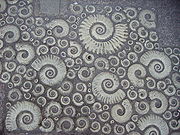
Lyme Regis Museum
Encyclopedia

Local museum
A local museum is a museum that covers local history. Its collection normally includes objects with a local connection of some sort. Such museums are often small in nature and have a low budget for their running costs...
in the town of Lyme Regis
Lyme Regis
Lyme Regis is a coastal town in West Dorset, England, situated 25 miles west of Dorchester and east of Exeter. The town lies in Lyme Bay, on the English Channel coast at the Dorset-Devon border...
on the Jurassic Coast
Jurassic Coast
The Jurassic Coast is a World Heritage Site on the English Channel coast of southern England. The site stretches from Orcombe Point near Exmouth in East Devon to Old Harry Rocks near Swanage in East Dorset, a distance of ....
in Dorset
Dorset
Dorset , is a county in South West England on the English Channel coast. The county town is Dorchester which is situated in the south. The Hampshire towns of Bournemouth and Christchurch joined the county with the reorganisation of local government in 1974...
, England
England
England is a country that is part of the United Kingdom. It shares land borders with Scotland to the north and Wales to the west; the Irish Sea is to the north west, the Celtic Sea to the south west, with the North Sea to the east and the English Channel to the south separating it from continental...
.
The museum building was commissioned in 1901 by Thomas Philpot, a relative of the fossil
Fossil
Fossils are the preserved remains or traces of animals , plants, and other organisms from the remote past...
collector Elizabeth Philpot
Elizabeth Philpot
Elizabeth Philpot was an early 19th century British fossil collector, amateur palaeontologist and artist who collected fossils from the cliffs around Lyme Regis in Dorset on the southern coast of England. She is best known today for her collaboration and friendship with the well known fossil...
, hence the name. The architect of the building was George Vialls, who also designed the nearby Guildhall (now the Town Hall). It is built on the site of the birthplace and home of the fossil hunter Mary Anning
Mary Anning
Mary Anning was a British fossil collector, dealer and palaeontologist who became known around the world for a number of important finds she made in the Jurassic age marine fossil beds at Lyme Regis where she lived...
. The family also ran a shop here.
The collections and subject areas exhibited include fossils from the surrounding area dating from the Jurassic
Jurassic
The Jurassic is a geologic period and system that extends from about Mya to Mya, that is, from the end of the Triassic to the beginning of the Cretaceous. The Jurassic constitutes the middle period of the Mesozoic era, also known as the age of reptiles. The start of the period is marked by...
period, geology, local maritime history, memorabilia, and writers associated with the town such as Jane Austen
Jane Austen
Jane Austen was an English novelist whose works of romantic fiction, set among the landed gentry, earned her a place as one of the most widely read writers in English literature, her realism and biting social commentary cementing her historical importance among scholars and critics.Austen lived...
and John Fowles
John Fowles
John Robert Fowles was an English novelist and essayist. In 2008, The Times newspaper named Fowles among their list of "The 50 greatest British writers since 1945".-Birth and family:...
. The curator at the museum is Mary Godwin.
An ornate example of Coade stone
Coade stone
Lithodipyra , or Coade stone, was ceramic stoneware that was often described as an artificial stone in the late 18th and early 19th centuries. It was used for moulding Neoclassical statues, architectural decorations and garden ornaments that were both of the highest quality and remain virtually...
work, in the form of ammonite
Ammonite
Ammonite, as a zoological or paleontological term, refers to any member of the Ammonoidea an extinct subclass within the Molluscan class Cephalopoda which are more closely related to living coleoids Ammonite, as a zoological or paleontological term, refers to any member of the Ammonoidea an extinct...
s is set into the pavement outside the museum, reflecting both local history (specifically Eleanor Coade
Eleanor Coade
Eleanor Coade was a devout Baptist and remained unmarried until her death on 16 November 1821 in Camberwell Grove, Camberwell, London. Her obituary notice was published in The Gentleman's Magazine which declared her ‘the sole inventor and proprietor of an art which deserves considerable notice’...
, the inventor of Coade stone) and the palaeontology for which Lyme Regis is well-known.

